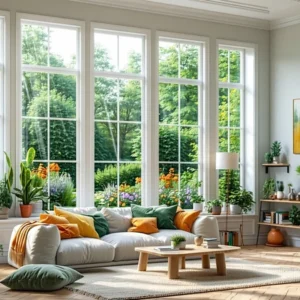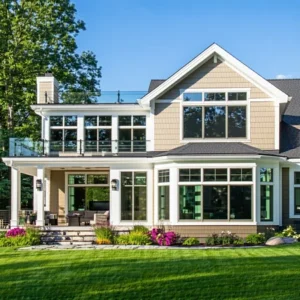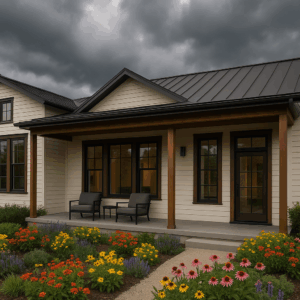Today’s roofing materials are known for their quality fabrication and durability, ready to withstand the harshest elements mother nature can throw our way.
But it certainly hasn’t always been the case. One of the first recorded roofs dates back to 40,000 BC, when some of our industrious ancestors took shelter under a roof made from the skin of a wooly mammoth.
Skip forward a few millennia, and the glazed clay roof tile was first used in China around 3,000BC, while Greece and Babylon used flat earthenware roof tiles between 3,000 and 2,000BC.
From humble beginnings, the simple roof has gone through a monumental evolution to arrive at the products and styles we know today.
If you’re thinking about repairing or replacing your roof, here are the basic components and materials you need to consider (no wooly mammoths were harmed in the manufacturing of these products!)
The Five Essential Components:
Roof Coverings
This can include shingles, tile, slate, or metal, along with an underlayment that protects the sheathing from exposure and weather.
Sheathing
Includes the boards or sheet materials that are fastened to the roof’s rafters to cover your house or structure.
Roof Structure
Rafters and trusses make up the roof’s structure and are constructed to support the sheathing.
Flashing
Sheet metal and other materials referred to as flashing are installed into a roof system’s various joints and valleys to prevent water from seeping in.
Drainage
A roof features elements like shape, slope, and layout that impact your roof’s ability to shed water.
Roofing Materials Explained
Asphalt Shingles
The majority of homeowners choose asphalt shingles due to low cost, straightforward installation and resiliency. Standard asphalt shingles are available in many color choices, which make them a nice choice for any architectural style. They are available in traditional 3-tab shingles or thicker laminated “architectural” shingles. Asphalt shingles are made of either a paper fiber mat (better suited for cold weather and wind resistance) or fiberglass (offers better fire and moisture resistance) impregnated with asphalt and coated with mineral granules. Typically, asphalt shingles will offer you one of the lowest priced options available on the market today. On the other side, asphalt shingles have a lower insulative value and a shorter lifespan than many other roofing materials now available.
Wood Shingles And Shakes
Wood shingles and wood shakes are available in a range of woods including cedar, redwood, and pine. Wood shingles are machine cut, while wood shakes are hand cut for a more rustic look. It is possible to purchase fire-resistant treated Class A wood shingles for an additional cost. Wood shingles and shakes can add attractive architectural details to bungalows and historic properties. Wood is a natural product and thus greener in some ways, but maintenance can be an issue. Though very attractive, wood roofing systems can have poor fire ratings and are vulnerable to rotting, splitting, and mold.
If you like the look of wood, but want something more affordable with less maintenance, you might consider metal roofing or synthetic shingles that mimic the look of wood without the drawbacks.
Metal (Steel, Aluminum, Tile, and Copper)
Metal roofing offers some of the coolest roofs available, both in terms of temperature, and possible architectural styles.
Available in copper, aluminum, and stainless steel, metal roofs often contain a significant percentage of recycled material. Metal roofing provides high thermal/solar reflectance and incredible durability, lasting on average nearly twice as long as wood or asphalt. Metal shingles are significantly lighter than most other roofing materials and very resistant to bad weather and wind lift. Metal shingles are available in many styles and generally mirror the look of traditional roof coverings like shingles, slate and tile. With metal, you can get the architectural style you want at the optimal price, and feel good about using an environmentally friendly material. This makes metal roofing systems a good choice for nearly any style home.
Recycled Synthetic Shingles
Recycled synthetic shingles, which are created from plastic or rubber, can be a great alternative to natural wood shingles or shakes. The shingles are shaped to mirror the look of wood or slate. Unlike traditional wood shingles, recycled synthetic shingles are UV-resistant, more moisture insensitive, can be more fire-resistant and have a longer lifespan. Some of the available recycled synthetic shingles offer a comparable lifespan to fifty-year asphalt shingles.
Clay And Concrete Tiles
While clay tiles are non-combustible and very durable, they are very heavy and require additional roof framing. Clay roofing tiles are available in lighter colors, which can reflect over 50% of solar energy and adhere to cool roof standards. Concrete roofing tiles also offer a great look and value to your home. Concrete tiles are versatile and come in many design options – colors, shapes and textures – to give homeowners many choices. Roof tiles are made from natural clay or concrete. Tile roofing materials are very durable and offer minimal maintenance. They are naturally fire-resistant, offer a significant level of insulation and have high impact and wind lift resistance. Tile is appealing primarily for homes in a Mediterranean, European or Mission style. The downsides of natural clay and concrete tile are weight and price.
{{cta(‘8c8ebe87-3dbb-47b1-b0ea-08ea42cf678a’)}}



